MYOCARD-DX- dopamine hydrochloride in dextrose injection
MYOCARD-DX by
Drug Labeling and Warnings
MYOCARD-DX by is a Prescription medication manufactured, distributed, or labeled by B. Braun Medical Inc.. Drug facts, warnings, and ingredients follow.
Drug Details [pdf]
-
DESCRIPTION
Dopamine Hydrochloride in 5% Dextrose Injection USP is prepared from Dopamine Hydrochloride and Hydrous Dextrose USP in Water for Injection USP. These solutions are for intravenous use only.
These solutions are sterile, nonpyrogenic, isotonic, and contain no bacteriostatic or antimicrobial agents or added buffers. They are intended for single use only. When smaller doses are required, the unused portion should be discarded.
Each 100 mL contains dopamine hydrochloride 80 mg or 160 mg and dextrose, hydrous, 5 g in water for injection, with sodium metabisulfite added 50 mg as a stabilizer; osmolar concentration, respectively 270 and 275 mOsmol/liter, pH 3.3 (2.5 - 4.5). pH may be adjusted with Hydrochloric Acid NF or Sodium Hydroxide NF, as required.
Dopamine administered intravenously is a myocardial inotropic agent which also may increase mesenteric and renal blood flow plus urinary output.
Dopamine hydrochloride is designated chemically, as 3,4-dihydroxyphenethylamine hydrochloride, a white crystalline powder freely soluble in water. Dopamine (also referred to as 3-hydroxytyramine) is a naturally occurring biochemical catecholamine precursor of norepinephrine.
The formulas of the active ingredients are:
Ingredients Molecular Formula Molecular Weight Hydrous Dextrose USP 
198.17 Dopamine Hydrochloride 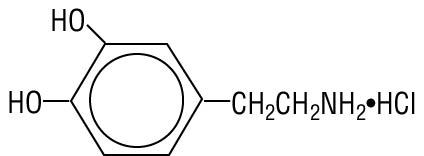
189.64
-
CLINICAL PHARMACOLOGY
Dopamine is a natural catecholamine formed by the decarboxylation of 3,4-dihydroxyphenylalanine (DOPA). It is a precursor to norepinephrine in noradrenergic nerves and is also a neurotransmitter in certain areas of the central nervous system, especially in the nigrostriatal tract, and in a few peripheral sympathetic nerves.
Dopamine produces positive chronotropic and inotropic effects on the myocardium, resulting in increased heart rate and cardiac contractility. This is accomplished directly by exerting an agonist action on beta-adrenoceptors and indirectly by causing release of norepinephrine from storage sites in sympathetic nerve ending.
Dopamine’s onset of action occurs within five minutes of intravenous administration, and with dopamine’s plasma half-life of about two minutes, the duration of action is less than ten minutes. If monoamine oxidase (MAO) inhibitors are present, however, the duration may increase to one hour. The drug is widely distributed in the body but does not cross the blood-brain barrier to a significant extent. Dopamine is metabolized in the liver, kidney, and plasma by MAO and catechol-O-methyltransferase to the inactive compounds homovanillic acid (HVA) and 3,4-dihydroxyphenylacetic acid. About 25% of the dose is taken up into specialized neurosecretory vesicles (the adrenergic nerve terminals), where it is hydroxylated to form norepinephrine. It has been reported that about 80% of the drug is excreted in the urine within 24 hours, primarily as HVA and its sulfate and glucuronide conjugates and as 3,4-dihydroxyphenylacetic acid. A very small portion is excreted unchanged.
The predominant effects of dopamine are dose-related, although actual response of an individual patient will largely depend on the clinical status of the patient at the time the drug is administered. At low rates of infusion (0.5-2 mcg/kg/min) dopamine causes vasodilation that is presumed to be due to a specific agonist action on dopamine receptors (distinct from alpha- and beta-adrenoceptors) In the renal, mesenteric, coronary, and intracerebral vascular beds. At these dopamine receptors, haloperidol is an antagonist. The vasodilation in these vascular beds is accompanied by increased glomerular filtration rate, renal blood flow, sodium excretion, and urine flow. Hypotension sometimes occurs. An increase in urinary output produced by dopamine is usually not associated with a decrease in osmolarity of the urine.
At intermediate rates of infusion (2-10 mcg/kg/min) dopamine acts to stimulate the beta1-adrenoceptors, resulting In improved myocardial contractility, increased SA rate and enhanced impulse conduction in the heart. There is little, if any, stimulation of the beta2-adrenoceptors (peripheral vasodilation). Dopamine causes less increase in myocardial oxygen consumption than isoproterenol, and its use is not usually associated with a tachyarrhythmia. Clinical studies indicate that it usually increases systolic and pulse pressure with either no effect or a slight increase in diastolic pressure. Blood flow to the peripheral vascular beds may decrease while mesenteric flow increased due to increased cardiac output. At low and intermediate doses, total peripheral resistance (which would be raised by alpha activity) is usually unchanged.
At higher rates of infusion (10-20 mcg/kg/min) there is some effect on alpha-adrenoceptors, with consequent vasoconstrictor effects and a rise in blood pressure. The vasoconstrictor effects are first seen in the skeletal muscle vascular beds, but with increasing doses they are also evident in the renal and mesenteric vessels. At very high rates of infusion (above 20 mcg/kg/min), stimulation of alpha-adrenoceptors predominates and vasoconstriction may compromise the circulation of the limbs and override the dopaminergic effects of dopamine, reversing renal dilation and natriuresis.
Dextrose provides a source of calories. Dextrose is readily metabolized, may decrease losses of body protein and nitrogen promotes glycogen deposition and decreases or prevents ketosis if sufficient doses are provided.
-
INDICATIONS AND USAGE
Dopamine Hydrochloride in 5% Dextrose Injection USP is indicated for the correction of hemodynamic imbalances present in the shock syndrome due to myocardial infarctions, trauma, endotoxic septicemia, open heart surgery, renal failure, and chronic cardiac decompensation as in congestive heart failure.
Where appropriate, restoration of blood volume with a suitable plasma expander or whole blood should be instituted or completed prior to administration of dopamine.
Patients most likely to respond adequately to administration of dopamine are those in whom physiological parameters such as urine flow, myocardial function, and blood pressure, have not undergone profound deterioration. Multiclinic trials indicate that the shorter the time interval between onset of signs and symptoms and initiation of therapy with volume correction and dopamine, the better the prognosis.
Poor Perfusion of Vital Organs - Urine flow appears to be one of the diagnostic signs by which adequacy of vital organ perfusion can be monitored. Nevertheless, the physician should also observe the patient for signs of reversal of confusion or comatose condition. Loss of pallor increase in toe temperature, and/or adequacy of nail bed capillary filling may also be used as indices of adequate dosage. Clinical studies have shown that when dopamine is administered before urine flow had diminished to levels approximately 0.3 mL/minute, prognosis is more favorable.
Nevertheless, in a number of oliguric or anuric patients, administration of dopamine has resulted in an increase in urine flow which in some cases reached normal levels. Dopamine may also increase urine flow in patients whose output is within normal limits and thus may be of value in reducing the degree of pre-existing fluid accumulation. It should be noted that at doses above those optimal for the individual patient, urine flow may decrease, necessitating reduction of dosage. Concurrent administration of dopamine and diuretic agents may produce an additive or potentiating effect.
Low Cardiac Output - Increased cardiac output is related to dopamine’s direct inotropic effect on the myocardium. Increased cardiac output at low or moderate doses appears to be related to a favorable prognosis. Increase in cardiac output has been associated with either static or decreased systemic vascular resistance (SVR). Static or decreased SVR associated with low or moderate increments in cardiac output is believed to be a reflection of differential effects on specific vascular beds with increased resistance in peripheral beds (e.g., femoral) and concomitant decreases in mesenteric and renal vascular beds. Redistribution of blood flow parallels these changes so that an increase in cardiac output is accompanied by an increase in mesenteric and renal blood flow. In many instances the renal fraction of the total cardiac output has been found to increase. Increase in cardiac output produced by dopamine is not associated with substantial decreases in systemic vascular resistance as may occur with isoproterenol.
Hypotension - Hypotension due to inadequate cardiac output can be managed by administration of low to moderate doses of dopamine, which have little effect on SVR. At high therapeutic doses, dopamine’s alpha adrenergic activity becomes more prominent and thus may correct hypotension due to diminished SVR. As in the case of other circulatory decompensation states, prognosis is better in patients whose blood pressure and urine flow have not undergone profound deterioration. Therefore, it is suggested that the physician administer dopamine as soon as a definite trend toward decreased systolic and diastolic pressure becomes evident.
-
CONTRAINDICATIONS
Dopamine hydrochloride should not be used in patients with pheochromocytoma.
Dopamine hydrochloride should not be administered in the presence of uncorrected tachyarrhythmias or ventricular fibrillation.
Solutions containing dextrose may be contraindicated in patients with hypersensitivity to corn products.
-
WARNINGS
Do not add any alkalinizing substance since dopamine is inactivated in alkaline solution.
Patients who have been treated with monoamine oxidase (MAO) inhibitors prior to the administration of dopamine will require substantially reduced dosage. See Drug Interactions below.
This product contains sodium metabisulfite, a sulfite that may cause allergic-type reactions including anaphylactic symptoms and life-threatening or less severe asthmatic episodes in certain susceptible people. The overall prevalence of sulfite sensitivity in the general population is unknown and probably low. Sulfite sensitivity is: seen more frequently in asthmatic than in nonasthmatic people.
Evidence is inadequate for fully defining proper dosage and limitation for use in children. (See PRECAUTIONS)
Solutions containing dextrose without electrolytes should not be administered simultaneously with blood through the same infusion set because of the possibility of agglomeration of erythrocytes.
The administration of intravenous solutions can cause fluid and/or solute overload resulting in dilution of serum electrolyte concentrations, overhydration, congested states or pulmonary edema.
Excess administration of potassium-free solutions may result in significant hypokalemia.
Because dosages of this drug are titrated to response (see DOSAGE AND ADMINISTRATION), no additives should be mixed with Dopamine Hydrochloride in 5% Dextrose Injection USP.
-
PRECAUTIONS
General
Control of the rate of infusion is essential to avoid inadvertent administration of a bolus of the drug (see DOSAGE AND ADMINISTRATION).
Clinical evaluation and periodic laboratory determinations are necessary to monitor changes in fluid-balance, electrolyte concentrations, and acid-base balance during prolonged parenteral therapy or whenever the condition of the patient warrants such evaluation.
Solutions containing dextrose should be used with caution in patients with overt or known subclinical diabetes mellitus, or carbohydrate intolerance for any reason.
If administration is controlled by a pumping device, care must be taken to discontinue pumping action before the container runs dry or air embolism may result.
Use only if solution is clear and vacuum is present.
Avoid Hypovolemia - Prior to treatment with dopamine hydrochloride, hypovolemia should be fully corrected, if possible, with either whole blood or plasma, as indicated. Monitoring of central venous pressure or left ventricular filling pressure may be helpful detecting and treating hypovolemia.
Hypoxia, Hypercapnia, Acidosis - These conditions, which may also reduce the effectiveness and/or increase the incidence of adverse effects of dopamine, must be identified and corrected prior to, concurrently with, administration of dopamine HCl.
Ventricular Arrhythmias - lf an increased number of ectopic beats are observed, the dose should be reduced if possible.
Decreased Pulse Pressure - If a disproportionate rise in diastolic pressure (i.e., a marked decrease in pulse pressure) is observed in patients receiving dopamine, the infusion rate should be decreased and the patient observed carefully for further evidence of predominant vasoconstrictor activity, unless such an effect is desired.
Hypotension - At lower infusion rates, if hypotension occurs, the infusion rate should be rapidly increased until adequate blood pressure is obtained. If hypotension persists, dopamine HCl should be discontinued and a more potent vasoconstrictor agent such as norepinephrine should be administered.
Extravasation - Dopamine Hydrochloride in 5% Dextrose Injection USP should be infused into a large vein whenever possible to prevent the possibility of extravasation into tissue adjacent to the infusion site. Extravasation may cause necrosis and sloughing of surrounding tissue. Large veins of the antecubital fossa are preferred to veins of the dorsum of the hand or ankle. Less suitable infusion sites should be used only if the patient’s condition requires immediate attention. The physician should switch to a more suitable site as soon as possible and the infusion site in use should be continuously monitored for free flow.
Occlusive Vascular Disease - Patients with a history of occlusive vascular disease (e.g., atherosclerosis, arterial embolism, Raynaud’s disease, cold injury, diabetic endarteritis, and Buerger’s disease) should be closely monitored for any changes in color or temperature of the skin of the extremities. If a change in skin color or temperature occurs and is thought to be the result of compromised circulation to the extremities, the benefits of continued dopamine infusion should be weighed against the risk of possible necrosis. These changes may be reversed by decreasing the rate or discontinuing the infusion entirely.
Important – Antidote for Peripheral Ischemia: To prevent sloughing and necrosis in ischemic areas, the area should be infiltrated as soon as possible with 10 to 15 mL of 0.9% Sodium Chloride Injection USP containing 5 to 10 mg of Regitine™ (brand of phentolamine), an adrenergic blocking agent. A syringe with a fine hypodermic needle should be used and the solution liberally infiltrated throughout the ischemic area. Sympathetic blockade with phentolamine causes immediate and conspicuous local hyperemic changes if the area Is infiltrated within 12 hours. Therefore, phentolamine should be given as soon as possible after the extravasation is noted.
Weaning — When discontinuing the infusion, it may be necessary to gradually decrease the dose of dopamine HCl while expanding blood volume with IV fluids, since sudden cessation may result in marked hypotension.
Drug Interactions
Cyclopropane or halogenated hydrocarbon anesthetics increase cardiac autonomic irritability and may sensitize the myocardium to the action of certain intravenously administered catecholamines, such as dopamine. This interaction appears to be related both to pressor activity and to the beta adrenergic stimulating properties of these catecholamines, and may produce ventricular arrhythmias. Therefore, EXTREME CAUTION should be exercised when administering dopamine HCl to patients receiving cyclopropane or halogenated hydrocarbon anesthetics. Results of studies in animals indicate that dopamine-induced ventricular arrhythmias during anesthesia can be reversed by propranolol.
Because dopamine is metabolized by monoamine oxidase (MAO), inhibition of this enzyme prolongs and potentiates the effect of dopamine. Patients who ave been treated with MAO inhibitors within two to three weeks prior to the administration of dopamine should receive an initial dose of Dopamine HCl no greater than one-tenth (1/10) of the usual dose.
Concurrent administration of low-dose dopamine HCl and diuretic agents may produce an additive or potentiating effect on urine flow.
Tricyclic antidepressants may potentiate the cardiovascular effects of adrenergic agents.
Cardiac effects of dopamine are antagonized by beta-adrenergic blocking agents, such as propranolol and metoprolol. The peripheral vasoconstriction caused by high doses of dopamine HCl is antagonized by alpha-adrenergic blocking agents. Dopamine-induced renal and mesenteric vasodilation is not antagonized by either alpha- or beta-adrenergic blocking agents.
Butyrophenones (such as haloperidol) and phenothiazines can suppress the dopaminergic renal and mesenteric vasodilation induced with low-dose dopamine infusion.
The concomitant use of vasopressors, vasoconstrictor agents (such as ergonovine) and some oxytocic drug may result in severe hypertension.
Administration of phenytoin to patients receiving dopamine HCl has been reported to lead to hypotension and bradycardia. It is suggested that in patients receiving dopamine HCl, alternatives to phenytoin should be considered if anticonvulsant therapy is needed.
Carcinogenesis, Mutagenesis, Impairment of Fertility
Long-term animal studies have not been performed to evaluate the carcinogenic potential of dopamine HCl.
Dopamine HCl at doses approaching maximal solubility showed no clear genotoxic potential in the Ames test. Although there was a reproducible dose-dependent increase in the number of revertant colonies with strains TA100 and TA98, both with and without metabolic activation, the small increase was considered inconclusive evidence of mutagenicity. In the L5178Y TK+/- mouse lymphoma assay, dopamine HCl at the highest concentrations used of 750 mcg/mL without metabolic activation, and 3000 mcg/mL with activation, was toxic and associated with increases in mutant frequencies when compared to untreated and solvent controls; at the lower concentrations no increases over controls were noted.
No clear evidence of clastogenic potential was reported in the in vivo mouse or male rat bone marrow micronucleus test when the animals were treated intravenously with up to 224 mg/kg and 30 mg/kg of dopamine HCl, respectively.
Pregnancy
Pregnancy Category C:
Teratogenic Effects: Teratogenicity studies in rats and rabbits at dopamine HCl dosages up to 6 mg/kg/day intravenously during organogenesis produced no detectable teratogenic or embryotoxic effects, although maternal toxicity consisting of mortalities, decreased body weight gain, and pharmacotoxic signs were observed in rats. In a published study, dopamine HCl administered at 10 mg/kg subcutaneously for 30 days, markedly prolonged metestrus and increased mean pituitary and ovary weights in female rats. Similar administration to pregnant rats throughout gestation or for 5 days starting on gestation day 10 or 15 resulted in decreased body weight gains, increased mortalities and slight increases in cataract formation among the offspring. There are no adequate and well-controlled studies in pregnant women, and it is not known if dopamine HCl crosses the placental barrier. Dopamine HCl should be used during pregnancy only if the potential benefit justifies the potential risk to the fetus.
Labor and Delivery
In obstetrics, if vasopressor drugs are used to correct hypotension or are added to a local anesthetic solution the interaction with some oxytocic drugs may cause severe hypertension.
Nursing Mothers
It is not known whether this drug is excreted in human milk. Because many drugs are excreted in human milk, caution should be exercised when dopamine is administered to a nursing mother.
Pediatric Use
Safety and effectiveness in pediatric patients have not been established. Dopamine HCl has been used in a limited number of pediatric patients, but such use has been inadequate to fully define proper dosage and limitations for use. Peripheral gangrene has been reported in neonates and children.
-
ADVERSE REACTIONS
The following adverse reactions have been observed, but there are not enough data to support an estimate of their frequency.
Cardiovascular System - Ventricular arrhythmia (at very high doses), ectopic beats, tachycardia, anginal pain, palpitation, cardiac conduction abnormalities, widened QRS complex, bradycardia, hypotension hypertension and vasoconstriction.
Respiratory System — Dyspnea.
Gastrointestinal System — Nausea and vomiting.
Metabolic/Nutritional System — Azotemia.
Central Nervous System — Headache and anxiety.
Dermatological System — Piloerection.
Other – Gangrene of the extremities has occurred when high doses were administered for prolonged periods or in patients with occlusive vascular disease receiving low doses of dopamine HCl.
Reactions which may occur because of the solution or the technique of administration include febrile response, infection at the site of injection, venous thrombosis or phlebitis extending from the site of injection, extravasation and hypervolemia.
If an adverse reaction does occur, discontinue the infusion, evaluate the patient, institute appropriate therapeutic countermeasures and save the remainder of the fluid for examination if deemed necessary.
-
OVERDOSAGE
In case of accidental overdosage, as evidenced by excessive blood pressure elevation, reduce rate of administration or temporarily discontinue dopamine until patients condition stabilizes. Since the duration of action of dopamine is quite short, no additional remedial measures are usually necessary. If these measures fail to stabilize the patients condition, use of the short acting alpha adrenergic blocking agent, phentolamine, should be considered.
-
DOSAGE AND ADMINISTRATION
Dopamine Hydrochloride in 5% Dextrose Injection USP is for intravenous use only.
Dosage is to be directed by a physician.
The less concentrated 400 mcg/mL or 800 mcg/mL solutions may be preferred when fluid expansion is not a concern.
Rate of Administration — Dopamine Hydrochloride in 5% Dextrose Injection USP is administered intravenously through a suitable intravenous catheter or needle. An IV drip chamber or other suitable metering device is essential for controlling the rate of flow in drops/min. Each patient must be individually titrated to the desired hemodynamic and/or renal response with dopamine. In titrating to the desired increase in systolic blood pressure, the optimum dosage rate for renal response may be exceeded, thus necessitating a reduction in rate after the hemodynamic condition is stabilized.
Administration at rates greater than 50 mcg/kg/min have safely been used in advanced circulatory decompensation states. If unnecessary fluid expansion is of concern, adjustment of drug concentration may be preferred over increasing the flow rate of a less concentrated dilution.
Suggested Regimen
- When appropriate, increase blood volume with whole blood or plasma until central venous pressure is 10 to 15 cm H2O or pulmonary wedge pressure is 14 to 18 mm Hg.
- Begin infusion of dopamine hydrochloride solution at doses of 2.5 mcg/kg/min in patients who are likely to respond to modest increments of heart force and renal perfusion.
In more seriously ill patients, begin infusion of dopamine hydrochloride at doses of 5 mcg/kg/min and increase gradually using 5 to 10 mcg/kg/min increments up to a rate of 20 to 50 mcg/kg/min as needed. If doses in excess of 50 mcg/kg/min are required, it is suggested that the urine output be checked frequently. Should urine flow begin to decrease in the absence of hypotension, reduction of dopamine dosage should be considered. Multiclinic trials have shown that more than 50% of the patients were satisfactorily maintained on doses of dopamine hydrochloride less than 20 mcg/kg/min. In patients who do not respond to these doses with adequate arterial pressure or urine flow, additional increments of dopamine may be employed in an effort to produce an appropriate arterial pressure and central perfusion. - Treatment of all patients requires constant evaluation of therapy in terms of blood volume, augmentation of myocardial contractility, and distribution of peripheral perfusion. Dosage of dopamine should be adjusted according to the patient’s response, with particular attention to diminution of established urine flow rate, increasing tachycardia or development of new dysrhythmias as indices for decreasing or temporarily suspending the dosage.
- As with all potent intravenously administered drugs, care should be taken to control the rate of infusion so as to avoid inadvertent administration of a bolus of the drug.
Parenteral drug products should be inspected visually for particulate matter and discoloration prior to administration, whenever solution and container permit.
-
AVAILABILITY
Dopamine Hydrochloride in 5% Dextrose Injection USP is supplied sterile and nonpyrogenic in glass containers with solid stoppers packaged 12 per case.
Cat. No. Size Dopamine HCl 200 mg in 5% Dextrose Injection USP
(Dopamine HCl 800 mcg/mL)D1442-60SS 250 mL Dopamine HCl 400 mg in 5% Dextrose Injection USP
(Dopamine HCl 1600mcg/mL)D1482-60SS 250 mL Exposure of pharmaceutical products to heat should be minimized. Avoid excessive heat. Protect from freezing. It is recommended that the product be stored at room temperature (25°C); however, brief exposure up to 40°C does not adversely affect the product.
Avoid contact with alkalies (including sodium bicarbonate), oxidizing agents or iron salts.
NOTE - Do not use solution if it is darker than slightly yellow or discolored in any other way.
-
Directions for Use of B. Braun Glass Containers Designed for use with a vented set.
Special Applications
1. Before use, perform the following checks:
Inspect each container. Read the label. Ensure solution is the one ordered and is within the expiration date.
Invert container and carefully inspect the solution in good light for cloudiness, haze, or particulate matter, check the bottle for cracks or other damage. In checking for cracks, do not be confused by normal surface marks and seams on the bottom and sides of the bottle. These are not flaws. Look for bright reflections that have depth and penetrate into the wall of the bottle. Reject any such bottle.
2. Remove plastic cap (See Figure 1).
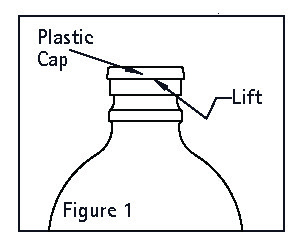
3. Swab exposed stopper surface with a suitable disinfectant.
4. If the first puncture of the stopper is the administration set spike, insert the spike fully into the target area of the rubber stopper and promptly invert the bottle (see Figure 2). Verify vacuum by observing rising air bubbles. Do not use the bottle if vacuum is not present. Refer to Directions for Use of air-inletting administration set to be used.
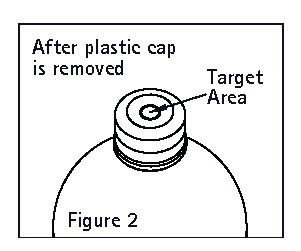
5. If set insertion is not performed immediately following swabbing, swab stopper again with a suitable disinfectant. -
SPL UNCLASSIFIED SECTION
CAUTION: FOODS, DRUGS, DEVICES AND COSMETICS ACT prohibits dispensing without prescription.
Regitine is a trademark of Novartis Corporation.
Manufactured by:
B. BRAUN MEDICAL INC.
Irvine, CA 92614-5895 USAImported & Distributed by:
PHIL PHARMAWEALTH, INC.
Suite 3001, East Tower, PSE Center,
Exchange Road., Ortigas Center,
Pasig City, PhilippinesY36-003-002 LD-341-5
-
PRINCIPAL DISPLAY PANEL
D.R. No.: XY35251
250 mL
Dopamine Hydrochloride in 5% Dextrose
MYOCARD-DX
200mg Pre-mixed Infusion Solution (I.V.)
ADRENERGIC AGENT
FORMULATION: Each 250mL contains:
Dopamine (as hydrochloride) . . . . . 200mgINDICATIONS: Correction of hemodynamic imbalances present in shock due to myocardial infarction, trauma, endotoxic septicaemia, open heart surgery, renal failure, and chronic cardiac decompensation as in refractory congestive failure.
DOSAGE & ADMINISTRATION: Refer to package insert.
CAUTION: FOODS, DRUGS, DEVICES AND COSMETICS ACT prohibits dispensing without prescription.
STORAGE: Store at temperatures not exceeding 25 °C. Avoid excessive heat. DO NOT FREEZE.
WARNING: Contains sodium metabisulfite that may cause hypersensitivity reactions.
"FOR FULL INFORMATION, SEE PACKAGE INSERT."
Manufactured by:
B. BRAUN MEDICAL INC.
Irvine, CA 92614-5895 USAImported & Distributed by:
PHIL PHARMAWEALTH, INC.
Suite 3001, East Tower, PSE Center, Exchange Road.,
Ortigas Center, Pasig City, PhilippinesD1442-60SS Y37-002-417 LD-339-2
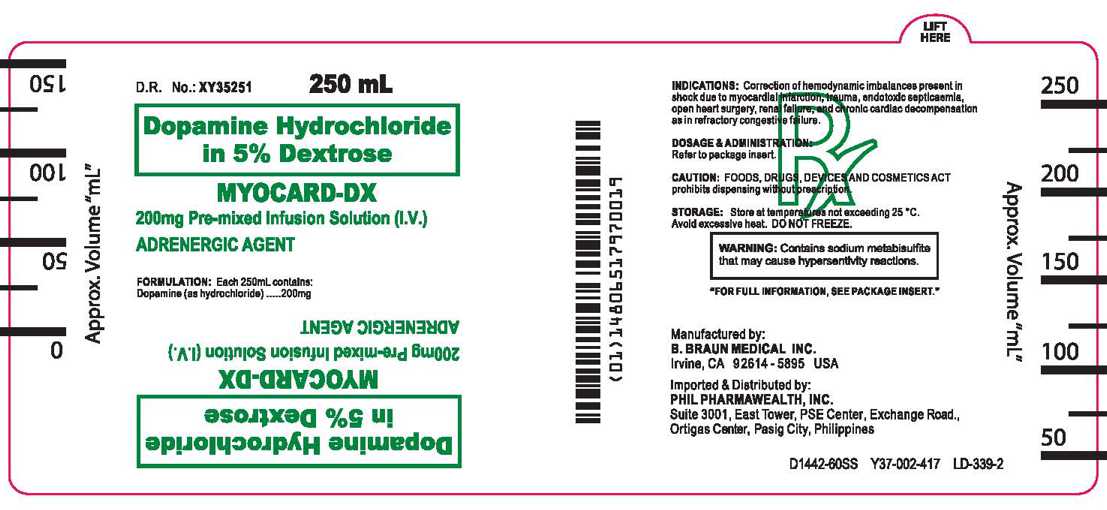
-
PRINCIPAL DISPLAY PANEL
D.R. No.: XY38703
250 mL
Dopamine Hydrochloride in 5% Dextrose
MYOCARD-DX
400mg Pre-mixed Infusion Solution (I.V.)
ADRENERGIC AGENT
FORMULATION: Each 250mL contains:
Dopamine (as hydrochloride) . . . . . 400mgINDICATIONS: Correction of hemodynamic imbalances present in shock due to myocardial infarction, trauma, endotoxic septicaemia, open heart surgery, renal failure, and chronic cardiac decompensation as in refractory congestive failure.
DOSAGE & ADMINISTRATION: Refer to package insert.
CAUTION: FOODS, DRUGS, DEVICES AND COSMETICS ACT prohibits dispensing without prescription.
STORAGE: Store at temperatures not exceeding 25 °C. Avoid excessive heat. DO NOT FREEZE.
WARNING: Contains sodium metabisulfite that may cause hypersensitivity reactions.
"FOR FULL INFORMATION, SEE PACKAGE INSERT."
Manufactured by:
B. BRAUN MEDICAL INC.
Irvine, CA 92614-5895 USAImported & Distributed by:
PHIL PHARMAWEALTH, INC.
Suite 3001, East Tower, PSE Center, Exchange Road.,
Ortigas Center, Pasig City, PhilippinesD1482-60SS Y37-002-418 LD-340-2
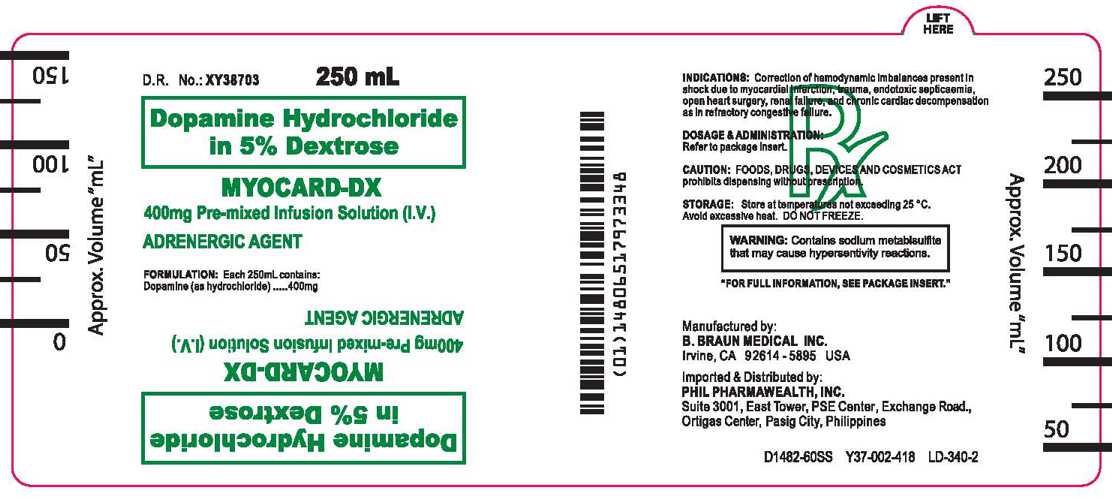
-
INGREDIENTS AND APPEARANCE
MYOCARD-DX
dopamine hydrochloride in dextrose injectionProduct Information Product Type HUMAN PRESCRIPTION DRUG Item Code (Source) NDC: 0264-1840 Route of Administration INTRAVENOUS Active Ingredient/Active Moiety Ingredient Name Basis of Strength Strength DOPAMINE HYDROCHLORIDE (UNII: 7L3E358N9L) (DOPAMINE - UNII:VTD58H1Z2X) DOPAMINE HYDROCHLORIDE 80 mg in 100 mL DEXTROSE MONOHYDRATE (UNII: LX22YL083G) (ANHYDROUS DEXTROSE - UNII:5SL0G7R0OK) DEXTROSE MONOHYDRATE 5 g in 100 mL Inactive Ingredients Ingredient Name Strength WATER (UNII: 059QF0KO0R) SODIUM METABISULFITE (UNII: 4VON5FNS3C) 50 mg in 100 mL Packaging # Item Code Package Description Marketing Start Date Marketing End Date 1 NDC: 0264-1840-20 12 in 1 CASE 03/01/2007 1 250 mL in 1 BOTTLE, GLASS; Type 0: Not a Combination Product Marketing Information Marketing Category Application Number or Monograph Citation Marketing Start Date Marketing End Date EXPORT ONLY 03/01/2007 MYOCARD-DX
dopamine hydrochloride in dextrose injectionProduct Information Product Type HUMAN PRESCRIPTION DRUG Item Code (Source) NDC: 0264-1880 Route of Administration INTRAVENOUS Active Ingredient/Active Moiety Ingredient Name Basis of Strength Strength DOPAMINE HYDROCHLORIDE (UNII: 7L3E358N9L) (DOPAMINE - UNII:VTD58H1Z2X) DOPAMINE HYDROCHLORIDE 800 mg in 100 mL DEXTROSE MONOHYDRATE (UNII: LX22YL083G) (ANHYDROUS DEXTROSE - UNII:5SL0G7R0OK) DEXTROSE MONOHYDRATE 5 g in 100 mL Inactive Ingredients Ingredient Name Strength WATER (UNII: 059QF0KO0R) SODIUM METABISULFITE (UNII: 4VON5FNS3C) 50 mg in 100 mL Packaging # Item Code Package Description Marketing Start Date Marketing End Date 1 NDC: 0264-1880-20 12 in 1 CASE 03/01/2007 1 250 mL in 1 BOTTLE, GLASS; Type 0: Not a Combination Product Marketing Information Marketing Category Application Number or Monograph Citation Marketing Start Date Marketing End Date EXPORT ONLY 03/01/2007 Labeler - B. Braun Medical Inc. (002397347) Establishment Name Address ID/FEI Business Operations B. Braun Medical Inc. 037425308 ANALYSIS(0264-1840, 0264-1880) , LABEL(0264-1840, 0264-1880) , MANUFACTURE(0264-1840, 0264-1880) , PACK(0264-1840, 0264-1880) , STERILIZE(0264-1840, 0264-1880)
© 2025 FDA.report
This site is not affiliated with or endorsed by the FDA.